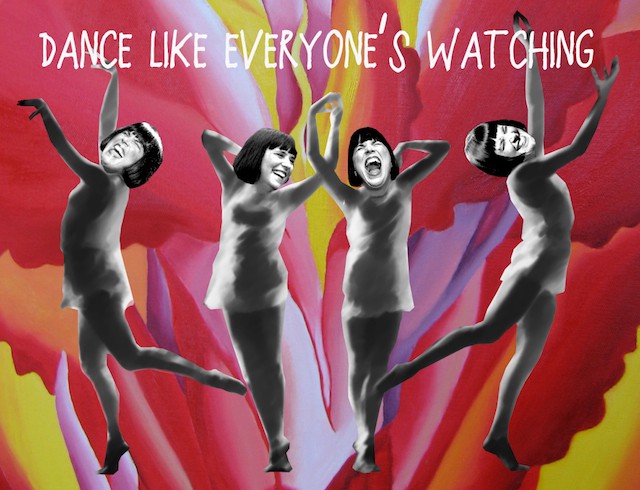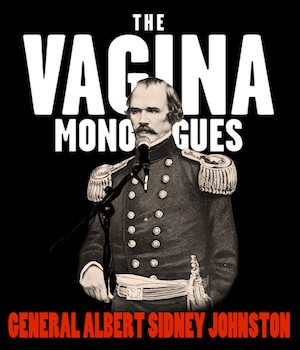The Limitations of Eve Ensler’s Dance-Based Activism
by Susan Schorn

“If your vagina could talk, what would it say?”
This question, from Eve Ensler’s Vagina Monologues, has probably been heard by hundreds of thousands of women by now. The play has been performed so often that an entire generation of feminists knows it by heart. It’s been staged in far-flung countries, and helped raise millions of dollars for women’s anti-violence groups.
I first heard the talking vagina question when it floated through the open window of the ground-floor office where I worked on a large university campus. Outside was a tree-shaded courtyard — a peaceful place, its atmosphere somewhat subdued by a brooding statue of Confederate General Albert Sidney Johnston. But a plucky young undergraduate, waiting to audition for a local production of The Vagina Monologues, chose to practice her lines there. Loudly. Repeatedly. And so my personal experience with Ensler’s play began as a gradual awareness that someone outside was asking the statue of Albert Sidney Johnston what its vagina would say if it could talk.
I certainly hope the young woman got the part she auditioned for, because she sounded really into it. She genuinely wanted to know what Albert Sidney Johnston’s vagina had to say. But despite her enthusiasm, and the well-established brilliance of Ensler’s writing, and the importance of The Vagina Monologues as a reclamation and celebration of women’s bodies — not to mention the sheer novelty of hearing a slave-owning, Indian-murdering career military officer being interrogated about his vagina — this impromptu performance wasn’t a catalyst for me. It didn’t awaken me to a new awareness of anything in particular. I was already involved in the fight to end violence against women, and only marginally interested in the anthropomorphic dimensions of vaginas.
I’ve remained on the margins of Enslermania ever since. Last year, when I first heard about One Billion Rising, the day of action Ensler had declared to “break the silence” about violence against women, I did not immediately think (as 999,999,999 other women evidently did), “Oh hooray, the famous vagina lady is doing something about violence!” Instead I thought, “They’re going to tell us to dance, aren’t they.” And indeed: “On February 14, 2013,” Ensler promised, “to break the silence and release their stories–politically, spiritually, outrageously–through art, dance, marches, ritual, song, spoken word, testimonies and whatever way feels right.” There were speeches and performances and a choreographed “Break the Chain” dance that everyone was invited up on stage to participate in. Everyone but me appeared to have a wonderful time.
I felt like we were collectively asking Albert Sidney Johnston about his vagina.
Because what happened at the Texas Capitol in the months after One Billion Rising crowded its steps with ecstatic dancers? In June, Governor Rick Perry called a special legislative session and launched a virulent attack on reproductive rights. I was at the capitol many times that summer, supporting Wendy Davis, Leticia Van De Putte, and all the legislators and staffers and healthcare providers and witnesses and volunteers who were there fighting for women’s right to control their own bodies. Yet despite all the dancing that had taken place four months earlier, the law passed. It also passed in spite of Wendy Davis’ filibuster, and testimony from traumatized women, and the expert advice of medical professionals.
Ensler’s conflation of dance with activism unsettles me. I have little faith in dance as a tool of social change. Dancing may make you feel great, but it doesn’t get people to the polls to vote, or persuade Supreme Court Justices, or inform policy debates. And I dislike the way One Billion Rising frames women’s bodies as spectacle, as if our anger and our healing have more meaning when they are enacted on a stage, and consumed by mass audiences (if you don’t already have doubts about Ensler’s appropriation of other women’s bodies, read the mind-bogglingly self-absorbed excerpt “The Congo Stigmata” from her new memoir). I find Ensler’s encomiums to dance faintly embarrassing, too, in the way they attribute a mystical quality to the “primitive” but “spiritual” customs of third-world women. I also think inviting us to “dance until the violence stops” encourages white western feminism’s lamentable tendency to try to solve the world’s problems by doubling down on activities that white western feminists already like. Being told that I can stop people’s abuse of me by dancing sounds an awful lot like all the people in my life who’ve told me, “You’d be so pretty if you’d just smile.”
Perhaps Ensler would say I need to learn more about dance; that I need to overcome my inhibitions, release myself from something or other; maybe visit the Congo and learn, as she did, that dance is “a formidable, liberating and transformative energy.” But I already have my own liberating and transformative art. I learned karate at the school where I now teach self defense. And because I’m a martial artist, I sympathize with Ensler’s promotion of physical, spiritually-inflected movement as a healing and empowering activity. But — also because I’m a martial artist — I see the limitations of that approach.
Dance and martial arts are disciplines with common roots. Both arts are uniquely local expressions of universal needs: dance fulfills needs of expression and communication; martial arts fulfills the need to protect one’s self, family, and home. Within a given culture, the two arts often share a vocabulary of similar movement and gesture. And both arts are also commonly appropriated by practitioners outside their culture of origin. Western women have — with varying degrees of cultural sensitivity — made deliberate use of both martial arts and dance to further feminist aims. For me, karate is just as personally liberating and transformative as dance is for Ensler.
But the martial arts are ultimately about impact, not expression or storytelling or moving an audience emotionally. All the discipline and practice and cultivation of spontaneity that make up the martial arts exist for one purpose: winning a fight. So your efficacy as a martial artist is continually tested and measured: Can you break a board? Two boards? A brick? Can you defend yourself against an opponent? Multiple attackers?
If you’re engaged in activism, simply expressing yourself isn’t enough. If you’re truly under attack, you don’t dance. You fight.
Is One Billion Rising helping us win the fight? What is its impact? Can we measure it? Ensler claims the event has been a success; that “said afterwards that she was “‘gobsmacked’ that the government doesn’t see the need for comprehensive and compulsory education for relationships and sex.” If they’d danced a little harder, would the government have seen the light?

Ensler also touts One Billion Rising’s impact in the U.S., implying that the event helped pass the Violence against Women Reauthorization Act: “campaigner Pat Reuss credits the campaign with support for and passage of” VAWA. Given that VAWA passed by a vote of 286–138 in the House of Representatives (the Nay votes were all Republicans) and 78–22 in Senate (ditto), it seems unlikely that One Billion Rising was really instrumental in tipping the vote.
“In Guatemala,” Ensler reports, “Marsha Lopez, part of the V-Day movement since 2001, says the most important result of One Billion Rising was the creation of a law for the criminalisation of perpetrators who impregnate girls under 14 years old.” Ensler provides no link to verify this claim, but according to press release posted on the One Billion Rising website, titled “V-DAY’S ONE BILLION RISING IS BIGGEST GLOBAL ACTION EVER TO END VIOLENCE AGAINST WOMEN AND GIRLS,” Ensler claims that “the European Parliament plenary voted the resolution ‘Elimination and prevention of all forms of violence against women and girls’ inspired by One Billion Rising activities.” It’s not clear what “inspired by” means, exactly. The resolution itself, which Ensler in her explanation of the new justice forums. “How do we create justice when the state is paralysed or against us? What does justice look like? How do we address root causes of violence? How do we join our struggles? How do we distinguish between justice and revenge?”
If your vagina could talk, General Johnston, what would it say?
Previously: The Shark Has Pretty Teeth, Dear: Why I Teach Women Self-Defense
Illustrations by Maya West.
Susan Schorn is the author of Smile at Strangers, and Other Lessons in the Art of Living Fearlessly; she also writes the column Bitchslap for McSweeney’s Internet Tendency.